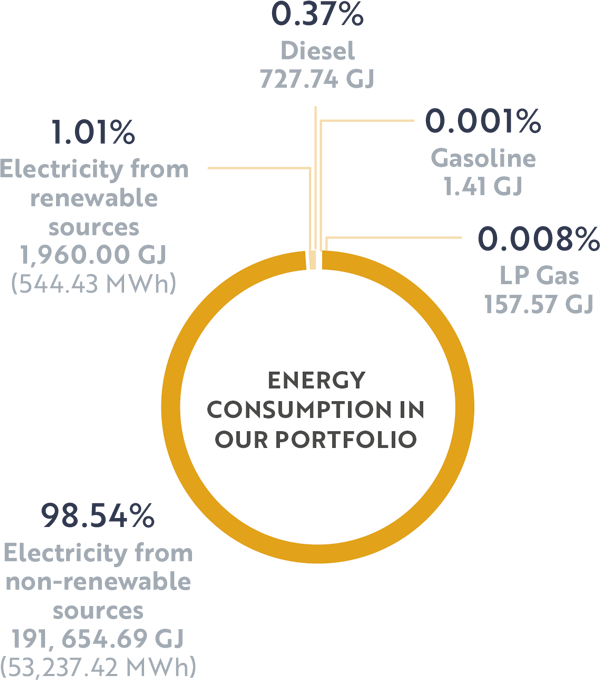3-3, 302-1, 302-3, IF-RE-130a.5, 2-4
Energy ![]()
We work with an ESG data intelligence platform, which measures our energy consumption directly from receipts and calculates scope 1 and 2 GHG emissions in real time, increasing the transparency and confidence of our data. In 2023, the organization’s total energy consumption was 194,501.36 GJ and energy intensity was 0.13 GJ/m2.
| ENERGY CONSUMPTION AND INTENSITY BY SUBSECTOR | ||
|---|---|---|
| Energy consumption (GJ) | Energy intensity (GJ/m2)* | |
| Offices | 18,339.80 | 0.26 |
| Shopping centers | 84,114.36 | 0.12 |
| Mixed use | 92,047.20 | 0.12 |
*The formula for calculating Fibra Danhos’ energy intensity was modified. Instead of measuring it based on square meters of gross leasable area (as in previous years), we find it more accurate to measure based on areas under our operational control. For more information on the criteria for defining organizational boundaries, please refer to the About This Report section in the appendix.

Total: 194,501.36 GJ
Energy efficiency
We are continually working to improve our energy efficiency under a comprehensive approach, through the following measures.
- Consumption optimization
We adjust the schedule of air conditioning and vertical transport equipment, ensuring that they operate efficiently and in line with actual needs. - Quantitative goals
These allow us to continually measure and evaluate our progress, identify areas for improvement and adjust strategies to achieve optimal levels of efficiency. - Investment in innovation and cutting-edge technology
We adopt the most advanced technologies to ensure efficient and sustainable performance. This includes everything from upgrading our lighting fixtures to LED bulbs, to the building management system for automation, monitoring and control.
- Ongoing training
We believe that energy awareness is fundamental to fostering responsible and sustainable practices in the workplace, so we train our staff on consumption reduction measures. - Renewable energy
We have an energy transition strategy which involves increasing the proportion of renewable energy in our portfolio, as a first step. - Quality audits
We conduct quality audits on a regular basis, to pinpoint the sources and equipment that consume the most energy, and make the necessary adjustments and improvements.
IF-RE-130a.5
Net-zero transition strategy
Fibra Danhos sees the energy transition not only as a logical decision, but also as essential to long-term profitability and to the benefit of stakeholders. We have worked on and analyzed multiple transition scenarios in recent years, while adjusting to the limitations of current regulations. However, within these limitations, we are seeking a strategy that aligns with the principles of efficiency, sustainability and corporate social responsibility.
Our energy transition strategy is based on five key steps to move towards sustainability and efficiency.

Parque Puebla
1

Energy efficiency
We at Fibra Danhos have been working toward the goal of optimizing energy efficiency since our inception, because we recognize that it is the first step towards achieving carbon neutrality. We have been introducing energy efficiency indicators year after year, while investing in high-technology equipment, and optimizing the current operation of the properties by consulting on the possibilities for retrofitting existing facilities.
Currently, there is little more we can do to become more energy efficient, because we have optimized virtually all of our equipment and operations. Nevertheless, we will continue to look for ways to further optimize our operations and to keep up with technological advances in the market.
2
Solar panels
The second step was to incorporate clean, renewable sources to power our operations. We installed solar panels in a two-phase project. The first phase, carried out in 2022, was to put in place two solar panel projects as a pilot test, one at Parque Delta and the other at Parque Tepeyac. In total, 600 kWp of renewable energy was installed.
The second phase began in 2023, with the installation of solar panels at nine properties: Parque Delta, Parque Lindavista, Parque Puebla, Parque Las Antenas, Parque Vía Vallejo, Toreo Parque Central, Reforma 222, Parque Duraznos and Urbitec. The total capacity of this phase is 6,021 kW and, with it, we reach the maximum solar power generation capacity that we have, due both to a space availability on our rooftops and because of energy regulations.
The installation program will conclude in the first half of 2024, and we expect all projects to be interconnected with CFE by mid-2024.
3
Wholesale power market
The third step in our transition strategy is to involve ourselves in the wholesale power market, with the goal of locating a qualified supplier who shares our vision of reducing environmental impact. By connecting with a supplier committed to sustainability, we plan to power our operations with cleaner, more efficient energy.
4
Reduce indirect impact, scope 3
Reducing scope 3 emissions requires a shared vision between Fibra Danhos and its stakeholders, as it involves the value chain. Although this relates closely to our activities, it is not directly under our operational control. Nevertheless, we know how important it is to include indirect impacts in our energy transition strategy. That is why we are exploring alternatives for helping our tenants reduce their emissions.
5

Impact mitigation
Once we have reduced our GHG emissions as much as possible, we are committed to pursuing impact mitigation measures so that, by 2050 at the latest, Fibra Danhos’ operations will be fully carbon neutral.
Through these four steps , we are building a solid, long-term strategy that will not only benefit our company but also help drive a more sustainable energy future and operate within the limits set for our planet.

Net zero emissions